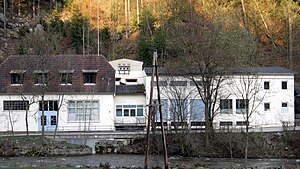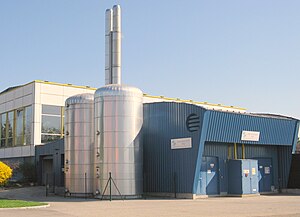Electric power station Perg
| Kegelschmiede power station | |||
|---|---|---|---|
| Power station building erected around 1910, continuously expanded | |||
| location | |||
|
|
|||
| Coordinates | 48 ° 16 '52 " N , 14 ° 39' 9" E | ||
| country | Austria | ||
| Waters | Naarn | ||
| Data | |||
| Type | Run-of-river power plant | ||
| Primary energy | Hydropower | ||
| power | 1.1 MW | ||
| owner | Elektrizitätswerk Perg GmbH | ||
| Start of operations | 1910 | ||
| turbine | 2 Francis turbines | ||
| Website | E-Werk Perg | ||
| was standing | 2.4.2009 | ||
| Aschermühle power plant | |
|---|---|
| location | |
| Coordinates | 48 ° 18 ′ 27 " N , 14 ° 40 ′ 37" E |
| country | Austria |
| Waters | Naarn |
| Data | |
| Type | Run-of-river power plant |
| Primary energy | Hydropower |
| power | 50 kW |
| owner | Elektrizitätswerk Perg GmbH |
| Start of operations | 1954 |
| turbine | 1 Kaplan turbine |
| Website | E-Werk Perg |
| was standing | 2.4.2009 |
| Toitschmühle power station | |
|---|---|
| location | |
| Coordinates | 48 ° 19 ′ 7 ″ N , 14 ° 41 ′ 20 ″ E |
| country | Austria |
| Waters | Naarn |
| Data | |
| Type | Run-of-river power plant |
| Primary energy | Hydropower |
| power | 500 kW |
| owner | Elektrizitätswerk Perg GmbH |
| Start of operations | 1978 |
| turbine | 1 Francis turbine |
| Website | E-Werk Perg |
| was standing | 2.4.2009 |
| Schartmühle power station | |
|---|---|
| location | |
| Coordinates | 48 ° 19 ′ 31 ″ N , 14 ° 41 ′ 35 ″ E |
| country | Austria |
| Waters | Naarn |
| Data | |
| Type | Run-of-river power plant |
| Primary energy | Hydropower |
| power | 1 MW |
| owner | Elektrizitätswerk Perg GmbH |
| Start of operations | 1985 |
| turbine | 1 Francis turbine |
| Website | E-Werk Perg |
| was standing | 2.4.2009 |
| Perg-Süd combined heat and power plant | |
|---|---|
| Perg-Süd BHKW in the school and leisure center | |
| location | |
| Coordinates | 48 ° 14 '24 " N , 14 ° 38' 27" E |
| country | Austria |
| Data | |
| Primary energy | natural gas |
| power | 920 kW electrical, 1200 kW thermal |
| owner | Elektrizitätswerk Perg GmbH |
| Start of operations | around 1999 |
| boiler | Loos gas boiler, 3000 kW |
| Firing | Jenbacher 20 cylinder gas engine |
| Website | E-Werk Perg |
| was standing | 2.4.2009 |
The owned by the municipality of Perg power station Perg GmbH is from the existing since 1910 electric power station of the municipality in 1999 Perg emerged.
According to its own information, the company supplies around 6,000 customers in the municipality of Perg and the neighboring communities with 65 million kilowatt hours of its own and purchased energy annually with its own four small hydropower plants on the Naarn and its own combined heat and power plant in the Perger school and leisure center .
The catchment area includes the entire or the larger part of the municipal areas of Allerheiligen , Münzbach , Perg and Windhaag , as well as the peripheral areas of the municipalities of Arbing, Mauthausen, Naarn, Rechberg and Schwertberg .
history
At the beginning of the 20th century there was a plan for a long time to use the water power of the Naarn with an electricity station . The slope in front of the Kuchelmühle was originally intended to be used (1906). Construction was delayed until the market town of Perg decided to buy the cone forge for this purpose. The company Siemens-Schuckert , Vienna, built the power station, which cost 220,000 peace kroner. A cable led the electricity into the market, where three transformer houses stood.
The Perger electricity works was originally designed for 120 HP (88 kW ) and supplied the Perg market with electricity. On January 1st, 1911, the electric street lighting was put into operation in Perg. With a second turbine, the installed power increased to 180 hp (132 kW). The first manager was Franz Schroll († 1926).
The neighboring communities of Weinzierl , Schwertberg, Pergkirchen , Altenburg , Windhaag bei Perg and Münzbach were gradually connected to the power grid. The connection line with the electricity and tram company in Linz went into operation in 1924. With the income from the power station, the municipality of Perg was able to service the loan taken out by Sparkasse Perg for the construction of the Perg secondary school.
At that time, the plant generated three-phase alternating current with a generator voltage of 5 kV and a mains frequency of 50 Hz. The connected transformer stations originally transformed the generator voltage to 3 × 210/120 V three-phase current. It was not until 1950 that the voltage was increased to 3 × 380/220 V three-phase current. To Linz, the plant now supplied electrical energy with a high voltage of 25 kV via a converter with an apparent power of 250 kVA.
In 1953, the expansion of the power station began at a cost of almost 9 million schillings. The financing took place by taking out an ERP loan in the amount of 4 million schillings, a bank loan in the amount of 3 million schillings as well as through the use of considerable own resources and received electricity prepayments. At that time, the E-Werk received the new weir system overgrowth and in addition two powerful new water turbines (from Andritz) at the old Kegelschmiede site and a little later two new diesel power generation units to significantly increase the performance, especially for winter operation.
The economic development of the Perger E-Werk shows the following figures about the electricity consumption in its own network:
| year | Kilowatt hours |
|---|---|
| 1933 | 950,000 |
| 1945 | 982,000 |
| 1955 | 1,760,000 |
| 1958 | 2,630,000 |
| 1968 | 6,515,000 |
| 2008 | 65,000,000 |
Regional energy supply
In 2009, Elektrizitätswerk Perg GmbH has four run-of-river power plants on the Naarn and a block-type thermal power station in the school and leisure center of Perg. 90 transformer stations were built to supply power to the 90 square kilometer region with around 6,000 consumers and around 12,000 residents.
The line network comprises a line network of around 500 kilometers in length, 390 kilometers of which are low-voltage lines , the rest is part of the medium-voltage network . Finally, fiber optic cables were also laid.
About a third of the electrical output comes from the company's own power plants, two thirds have to be bought in. 17 employees are employed.
Operations manager
- 1910 / 1911–1926 Franz Schroll
- 1926–1938 Rudolf Glaser
- 1938–1945 Erwin König
- 1945–1955 Heinrich Ebner
- 1956–1962 Franz Schönbeck
- 1963–1970 Josef Tremetsberger
- 1970–1997 Josef Knoll
- 1997 to date Helmut Puchmayr
Small hydropower plants
The small hydropower plant, which was built at the original location in the cone forge in 1909/10 and expanded from 1954 to 1956, now has two Francis turbines with a total of 1.1 MW (810 hp) and three diesel emergency power generators with 2 MW (1,472 hp) and an annual working capacity of 8,013 MWh. Fall height 75 m. 1991 to 1996 the pressure pipeline and the electrics were renewed.
In the seventies and eighties of the 20th century, the power station of the city of Perg built further small hydropower plants:
- 1954 Aschermühle site, 1 Kaplan turbine with 50 kW, (68 HP), annual working capacity 250 MWh, head 2.7 m; in 1998 a general renovation took place
- 1978 Toitschmühle site, 1 Francis turbine with 500 kW (680 PS), annual working capacity 3,430 MWh, head 35 m;
- 1985 Schartmühle site, 1 Francis turbine with 1 MW (1,360 hp), annual working capacity 5,664 MWh, head 47 m;
Block-type thermal power station
At the end of the nineties of the 20th century, the Perg power station put the Perg-Süd combined heat and power station into operation in the leisure and school center of the city of Perg.
Electrical and thermal energy is generated by coupling a gas engine to a generator. The generator converts the motor shaft power into electrical energy. The waste heat generated by the engine and the exhaust pipe is extracted via a heat exchanger and fed into the heating system.
The heat is transferred from the heating system to the surrounding public buildings via a water-filled, underground local heating network . The local heating network consists of insulated, underground steel pipelines with a length of around 650 m, with extensions still possible.
A gas boiler and buffer storage are available to cover heat peaks or to ensure the supply in the event of a motor failure. By shutting down the heating systems in public buildings and heating them with the block-type thermal power station, a significant reduction in environmental pollution is achieved.
The technical data of the system:
Motor: 20 cylinder gas engine, make Jenbacher, electrical output: 920 kW, thermal output: 1200 kW, gas boiler: make Loos, thermal output: 3000 kW, buffer storage: 2 pieces each 41,000 l
With the energy from the block-type thermal power station, hall and Heated outdoor pool, HTL, HLW, music school, sports hall, secondary school II, HAK, BORG and polytechnic school.
literature
- Florian Eibensteiner, Konrad Eibensteiner: The home book of Perg . Self-published, Linz 1933.
- Stadtgemeinde Perg (Ed.): Perg, Festschrift on the occasion of the city survey in 1969 . Self-published, Linz 1969.
- Local report Perg . In: Bezirksrundschau . No. 15 .. Perg April 9, 2009.
Individual evidence
- ↑ Supply area Elektrizitätswerk Perg ( page no longer available , search in web archives ) Info: The link was automatically marked as defective. Please check the link according to the instructions and then remove this notice.
Web links
- Homepage of Elektrizitätswerk Perg GmbH, ewerk-perg.at


